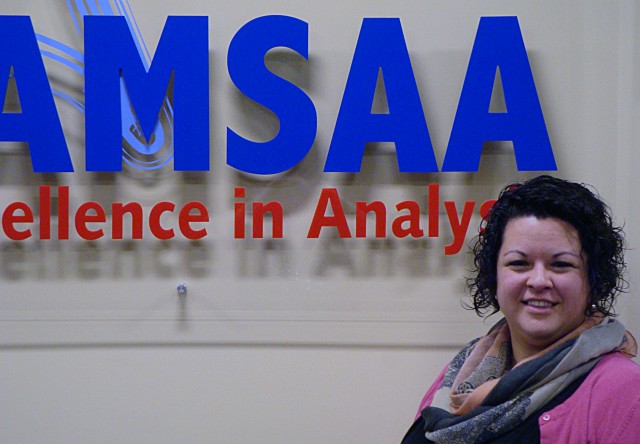
ABERDEEN PROVING GROUND, Md. -- An operations research analyst for the U.S. Army Materiel Systems Analysis Activity supported the Forward Analysis Support Team at the Pentagon during a recent developmental assignment.
Sarah Webster began working at AMSAA in 2009 supporting many types of analysis, such as cost benefit analysis, business case analysis, economic analysis, level of repair analysis, and initial provisioning analysis. After receiving her Master of Science degree in Operations Research from the Florida Institute of Technology, she decided she wanted to do more. That's when she expressed her interest in a developmental assignment. AMSAA management later approached her to be the first analyst to support FAST.
FAST was created by Dr. William Forrest Crain, director of the Center for Army Analysis.
"I created the FAST to provide responsive, on site decision support analysis to our decision makers in the Pentagon," Crain stated.
Webster supported the FAST from October 2015 to September 2016.
"I was actually the first member of the FAST Team to be in the Pentagon to solely perform this role," said Webster. "They wanted to expand the Pentagon's awareness of what AMSAA is and what we do. You're not just representing AMSAA when you're there, it's so much more than that. You're the face of the Army analytical community."
Webster had daily opportunities to make a huge impact on Army operations during her assignment.
"I was sitting next to my co-worker and he had a group pulling data and performing an analysis and they came back with a number that was orders of magnitude greater than what he had predicted. He knew something was wrong with the analysis," Webster said. "I offered to help and re-ran the analysis."
After analyzing her methodology, he agreed and immediately emailed the results to Senior Department of Defense leaders.
"What took the other people ultimately three weeks to get the answer, it took me a day and a half," Webster said.
When asked what she learned during her assignment with FAST, Webster responded, that it was a wonderful experience.
"I got to see where my little part goes into the acquisition lifecycle and see how doing analysis up front, making tough decisions -- even before we really have a platform to work with -- really shapes how the Soldiers are going to be able to use the equipment. It even shapes their chances of coming home to their families," said Webster.
Webster also received a better insight into what drives senior leader decision-making.
"Army senior leaders want to know what's the survivability, what's the lethality, what capabilities does it have and what's the bang for the buck. They want to see the hard numbers," said Webster. "The questions that they're asking are trickling down and I'm seeing the impacts of those questions on the work that AMSAA does as a whole. AMSAA has a very good reputation in the Pentagon and it's because of the great work that we're able to do."
Webster has transitioned back to AMSAA and looks back fondly on her assignment. It is her hope that many others will follow in her footsteps and participate in this career-changing opportunity.
"I loved what I was doing before and I love what I'm doing now, because I'm helping the Warfighter. I can't ask for any more than that. I have uncles who have served in all branches of the military and I have cousins who are currently serving in the Marine Corp and Air Force. I'm doing something that could potentially help bring them home. It hits very close to home for me," said Webster.
****
AMSAA conducts analyses across the Materiel Lifecycle to inform critical decisions for current and future Warfighter needs while valuing the unique knowledge, experiences, and backgrounds of its people.

Social Sharing